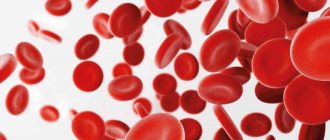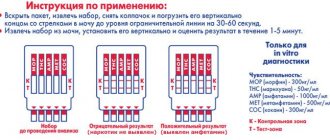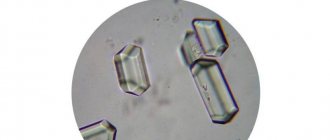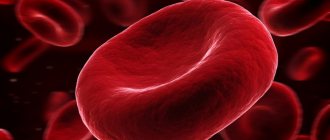Published: 04/20/2021 11:00:00 Updated: 04/20/2021
Erythrocytes are red blood cells containing hemoglobin. They carry oxygen and perform many important functions in the bloodstream.
We talked in more detail about red blood cells in the blood earlier.
In urine, red blood cells are contained in extremely small quantities. This is because these red blood cells are large enough that they normally do not pass through the kidney filter. If a lot of blood gets into the urine, it can be seen with the naked eye - the liquid changes color to pinkish or brown. A change in the color of urine is an alarming symptom.
However, a slight increase in red blood cell levels cannot be detected on your own. In this case, laboratory diagnostics will help. Red blood cells in the urine are determined as part of a general urine test.
General information
Red blood cells are hemoglobin-containing blood cells that provide gas exchange in the body and maintain its acid-base balance. They are quite large in size and normally cannot penetrate the kidney filter. Therefore, in a healthy person, red blood cells are contained in the urine only within certain limits. The presence of a larger number of red blood cells in urine may indicate disturbances in the functioning of the organs of the urinary system, latent/sluggish inflammatory and infectious diseases or other physiological processes in the body.
A test for red blood cells in urine is carried out as part of a general analysis (GAM) and in some cases is mandatory. Laboratory testing of urine for the content of red blood cells involves microscopy of its sediment, which is formed as a result of centrifugation. This technique allows you to accurately determine the concentration of formed elements: leukocytes, casts and, of course, erythrocytes.
Red blood cells contain hemoglobin, a pigment protein that transports oxygen and carbon dioxide. It also gives red blood cells their red color. Depending on the volume of hemoglobin, microscopy of urine sediment can reveal two types of red blood cells:
- unchanged (contain hemoglobin) - rich red color, have the shape of a concave disk;
- leached (do not contain hemoglobin) - colorless, often ring-shaped. The release of hemoglobin in this case occurs for a number of reasons: disruption of the glomerular filtration process, prolonged presence of red blood cells in the urine, etc.
The main functions of red blood cells in the body
- Ensuring cellular “respiration” (transportation of oxygen and carbon dioxide);
- Ensuring antigen specificity for blood groups;
- Ensuring the body's acid-base balance and osmotic pressure.
Red blood cells are produced mainly in the bone marrow of the spine, ribs and pelvic bones. Their membrane is permeable to oxygen, potassium, sodium, carbon dioxide and water. This property makes red blood cells important participants in almost all metabolic processes in the body. They circulate in the blood plasma (lifespan is 3-4 months), after which they are broken down in the liver and spleen.
Causes of red blood cells in urine
The large size of red blood cells does not allow them to pass through the filtration barrier of the glomeruli of the kidneys, so they are laboratory detected in urine in negligible quantities. But there are pathological conditions in which a fairly large number of red blood cells are detected in the urine (erythrocyturia, hematuria). This:
- Damage to the mucous membrane of the walls of the urinary organs as a result of inflammatory/infectious processes, benign and malignant formations, urolithiasis, trauma or surgery.
- High permeability of renal vessels in nephrotic syndrome, glomerulonephritis, pyelonephritis, renal failure, kidney cancer, etc.
- Congestion in the pelvic organs (phlebitis, thrombosis, compression of veins, etc.).
Microhematuria does not affect the color and clarity of urine. Macrohematuria is visually determined by a red, brown or brown tint of urine with impaired transparency.
1.General information
Normally, biological fluids of the human body should maintain a relatively constant composition (“relatively”, since it changes within limits determined by nature under the influence of situational, nutritional, age-related and a number of other factors) and not contain impurities. The presence of blood where it normally should not be is in any case a sign of a serious problem. That is why one of the most important, informative, and, if elevated, alarming indicators in a laboratory general clinical analysis of urine is the presence (and quantity) of red blood cells, or erythrocytes. This phenomenon is called erythrocyturia and is a special case of hematuria.
Hematuria, - from the Greek. “blood in the urine” – divided into two categories based on severity; The criterion for such separation is the visual evidence of the presence of blood. If the color of urine noticeably shifts towards the red part of the color gradient (acquiring, for example, pink, dark red or another similar shade), we speak of gross hematuria. If the presence of blood in the urine can only be determined under a microscope, then microhematuria is diagnosed. Erythrocyturia is designated as a separate term because the more general term “hematuria” implies the presence in the urine of not only red blood cells, but also other blood cells and components.
Transient (transient) erythrocytes are considered physiologically normal if no more than two erythrocytes are visible in the field of view under a microscope. Such a small number may indeed be due to non-pathological factors (for example, a particle of menstrual blood is accidentally mixed into the material donated by a woman). But if the limit is exceeded, and especially if this is confirmed by repeated analysis, this situation cannot be ignored.
Sign up for a consultation
A must read! Help with treatment and hospitalization!
Indications for analysis
Are common
- Mandatory screening examination when registering at a dispensary, prof. inspections, etc.;
- Diagnosis of somatic (internal) diseases;
- Monitoring the condition of patients with acute intoxication (poisoning), sepsis (blood infection);
- Monitoring the condition of patients during remission, as well as rehabilitation after surgery;
- Control and preventive examination of patients with a history of diseases of the genitourinary system;
- Assessment of the health status of children of the younger age group.
Symptomatic
- Change in urine color, presence of blood impurities;
- Bloody vaginal discharge (not of a menstrual nature);
- Pain in the lumbar region, side or lower abdomen;
- Frequent urge to urinate;
- Difficulty urinating, feeling of incomplete emptying of the bladder;
- Burning, itching, pain during and after urination;
- Increased body temperature, fever for several days;
- Digestive disorders (lack of appetite, nausea and vomiting);
- Hypertension (increased blood pressure).
Red blood cells are examined as part of the OAM, so the rules for preparing for the study are standard. Before collecting urine, it is recommended to avoid taking ascorbic acid, acidic foods and drinks.
Interpretation of TAM for red blood cells is carried out by a urologist, nephrologist, gynecologist, oncologist, family doctor, infectious disease specialist and pediatrician.
Norms of red blood cells in urine
| Patient | Number of red blood cells in the field of view |
| Women | No more than 3 (up to 5) |
| Men | No more than 1-2 |
| Children | 1-2 |
| Newborns (up to 1 month) | Up to 4 (due to the functional immaturity of the glomerular membrane) |
Factors influencing the result
- Overheating of the body (working in a hot shop, visiting a solarium or bathhouse, prolonged exposure to direct sunlight, etc.);
- Heavy physical activity and emotional stress;
- Intense sports training;
- Alcohol abuse (causes microspasms of renal vessels);
- Excess of acidic foods and drinks, spicy and spicy foods in the daily diet;
- Long-term treatment with ibuprofen, methenamine, sulfonamides, anticoagulants, vitamin C.
Temporary erythrocyturia, provoked by one or more of the above factors, is regarded as a variant of the norm.
With repeated OAM and exclusion of influencing factors, red blood cells in the urine should normalize. Important! The interpretation of the results is always carried out comprehensively. It is impossible to make an accurate diagnosis based on only one analysis.
3. Symptoms and diagnosis
The main symptom of erythrocyturia, in fact, is reflected in the name and described above. The remaining clinical manifestations and subjective complaints (pain, heaviness, problems with urination, general malaise, etc.), as well as their severity, are determined by the specific cause of the presence of blood in the urine. It is important to note that there may not be symptoms as such, but the phenomenon itself in this case does not become harmless and safe. In general, hematuria is one of the most dangerous symptoms in medicine in general, and measures should be taken in any case.
Depending on the suspected causes, one or another set of diagnostic procedures, laboratory and imaging (detailed biochemical tests, urethroscopy, X-ray, MRI, etc.) is prescribed.
About our clinic Chistye Prudy metro station Medintercom page!
Increased values (hematuria)
Highlight
- mild hematuria (microhematuria): up to 20 red blood cells in the field of view;
- moderate: 20-200 red blood cells;
- severe (macrohematuria): more than 200 red blood cells in the visual field.
Hematuria is diagnosed by the presence of more red blood cells in the urine and is of three types: somatic, renal, renal associated and postrenal.
1. Causes of somatic hematuria:
- hemophilia (blood clotting disorder due to decreased production of clotting factors);
- thrombocytopenia (decreased platelet count, provokes increased bleeding);
- hemoglobinuria (presence of hemoglobin in the urine);
- intoxication of the body with waste products of bacteria and viruses (causes dysfunction of the glomerular membrane of the kidneys);
- poisoning with medications, chemical reagents (benzene, aniline, etc.), snake and spider venom, mushrooms, etc.
2. Renal hematuria, related to the activity of the kidneys, is divided into glomerular and extraglomerular:
Glomerular is combined with proteinuria, erythrocyte casts and altered erythrocytes in the urine, the color of the urine is brown, occurs with:
- Benign familial hematuria
- Glomerulonephritis
- Alport syndrome (hereditary nephritis)
- IgA nephropathy
Extraglomerular is also combined with proteinuria, but there are no red blood cell casts in the urine, the color of the urine is reddish or pink:
- Tubulointerstitial nephritis
- Polycystic kidney disease
- pyelonephritis (infectious inflammation of the kidneys, provokes increased vascular permeability);
- oncological processes (a cancerous tumor proliferates and grows into the vessels of the kidneys, causing bleeding with unchanged red blood cells entering the urine);
- kidney stones (stones block the renal collecting system, which can lead to vascular damage and bleeding);
- hydronephrosis (stretching of the kidney due to impaired urine outflow);
- kidney injury (rupture, penetrating knife or gunshot wound, illiterate surgical intervention complicated by bleeding).
3. Postrenal, related to the urinary tract:
- cystitis (inflammation of the bladder);
- urolithiasis (a stone in the urethra or bladder injures the mucous membrane, causing bleeding);
- tumor processes (cancer of the bladder, urethra, prostate, uterus or ovaries leads to vascular proliferation and bleeding);
- injuries of the genitourinary organs;
- prostatitis (inflammation of the prostate);
- Benign prostatic hyperplasia;
- urethritis (inflammation of the urethra) in men and women;
- pathological uterine bleeding, in which blood from the vagina can enter the urine during urination;
- cervical erosion (violation of the integrity of the cervical epithelium, which leads to damage to blood vessels).
Also, red blood cells in the urine can appear as a result of:
- cardiovascular diseases: heart failure, myocardial infarction, hypertension;
- taking anticoagulants;
- infectious and inflammatory diseases: mononucleosis, tuberculosis, tonsillitis, malaria, severe forms of influenza;
- autoimmune disorders (systemic lupus erythematosus);
- varicose veins of the bladder neck.








